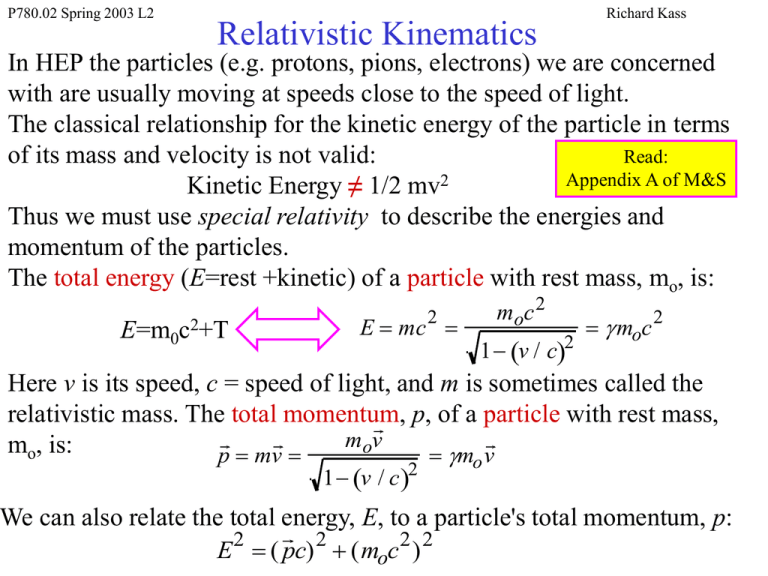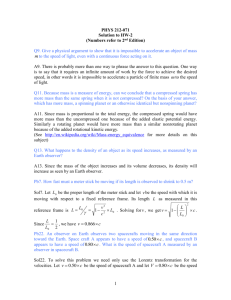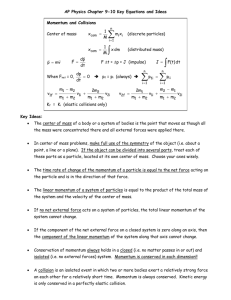Lecture 2, Relativistic Kinematics
advertisement

P780.02 Spring 2003 L2 Relativistic Kinematics Richard Kass In HEP the particles (e.g. protons, pions, electrons) we are concerned with are usually moving at speeds close to the speed of light. The classical relationship for the kinetic energy of the particle in terms of its mass and velocity is not valid: Read: Appendix A of M&S Kinetic Energy ≠ 1/2 mv2 Thus we must use special relativity to describe the energies and momentum of the particles. The total energy (E=rest +kinetic) of a particle with rest mass, mo, is: E=m0 c2+T 2 E mc moc 2 1 v / c2 moc 2 Here v is its speed, c = speed of light, and m is sometimes called the relativistic mass. The total momentum, p, of a particle with rest mass, mov mo, is: p mv mo v 2 1 v / c We can also relate the total energy, E, to a particle's total momentum, p: 2 2 2 2 E ( pc) (moc ) P780.02 Spring 2003 L2 Richard Kass Relativistic Kinematics 4-vectors It is sometimes convenient to describe a particle (or a collection of particles) by a 4-vector. The components of the momentum and energy 4-vector, p, are given by: p ( E , p x , p y , p z ) or p ( E , p ) or p ( E , p) with c 1 The length of the 4-vector is given by: 2 2 2 2 2 2 mo2 E p E px py pz A particle is said to be “on the mass shell” if m0=rest mass This relationship is true in ALL reference frames (lab, center of mass,…) because it is a Lorentz invariant. A 4-vector with length L2 is classified as follows: Time like if L2 >0 Space like if L2<0 Light like if L2=0 (think photon!) P780.02 Spring 2003 L2 Richard Kass Lorentz Invariant Vs. Conserved quantity With a Lorentz Invariant you get the same number in two different reference systems (it is a scalar). Let EL and pL be energy and momentum measured in LAB frame Let Ecm and pcm be energy and momentum measured in center of mass frame Then: E2cm-p2cm= E2L-p2L Since (E, p) is a Lorentz invariant (as long as both are measured in same system) With a conserved quantity you get the same number in the same reference system but at a different time. Let piL=initial momentum in lab (before collision) Let pfL=final momentum in lab (after collision) Let picm=initial momentum in CM (before collision) Let pfcm=final momentum in CM (after collision) Momentum conservation says: piL= pfL AND picm= pfcm BUT NOT piL= pfcm Relativistic Kinematics 4-vectorsRichard Kass P780.02 Spring 2003 L2 We can also manipulate 4-vectors using contravariant/covariant (up/down) notation: m02=pupu=guvpvpu In this notation guv is a metric and is given (e.g.) by: 1 0 0 0 0 1 0 0 g 0 0 1 0 0 0 0 1 Thus the (scalar) product of two 4-vectors (a, b) is given by: 3 3 ab a b g a b g a b aob o a1b1 a 2b 2 a3b3 0 0 The sum of two 4-vectors is also a 4-vector. p1 p2 (E1 E2 , p1 p2 ) The length of the sum of the 4-vectors of two particles (1,2) is: (p1 p2 ) 2 (E1 E2 )2 ( p1 p2 )2 (p1 p2 ) 2 E12 E22 2E1E2 p12 p22 2 p1 p2 2 (p1 p2 ) 2 m12 m22 2(E1 E2 | p1|| p2 |cos ) m12 =angle between particles, m1, m2 are rest masses m12 is called the invariant mass or effective mass P780.02 Spring 2003 L2 Richard Kass Relativistic Kinematics 4-vectors Example: Consider a proton at rest in the lab frame and an antiproton with 10GeV/c of momentum also in the lab frame. What is the energy of the antiproton in the lab frame? Since the rest energy of a particle is a Lorentz invariant we can make us of: 2 2 c=1 mo2 E p For an antiproton the rest mass, m0, = 938 MeV/c2. We can re-write the above as: 2 2 E p mo 102 0.9382 10.044 GeV Thus at high energies (E>>m0c2) E |p|. How fast is the anti-proton moving in the lab frame ? We need to remember the energy/momentum relationship between the rest frame (particle at rest) of the anti-proton and the lab frame: m0 c 2 m0 v 1 Elab m0 c 2 plab m0 c v / c, 1 (v / c) 2 1 (v / c) 2 1 2 plab / Elab m0 c / m0 c 2 10 / 10.044 0.996 Thus v = 0.996c (fast!) P780.02 Spring 2003 L2 More Relativistic Kinematics Richard Kass Colliding beam vs fixed target Collisions As we will see later in the course cross sections and the energy available for new particle production depend on the total energy in the center of mass (CM) frame. We define the CM where the total vector momentum of the collision is zero. By definition then, in the CM frame we have for two 4-vectors (p1, p2): (p1+p2)= (E1+E2, p1+p2) = (E1+E2, 0) If the masses of the two particles are equal as in the case of proton anti-proton collisions then the above reduces to: (p1+p2)= (E1+ E2, p1+ p2) = (E1+ E2, 0)= (2E, 0) (twice energy of either particle) NOTE: the square of the energy in the CM is often called s. s= magnitude of (p1+p2) How much energy is available in the CM from a 10 GeV/c anti-proton colliding with a proton at rest? Since (p1+p2) is a Lorentz invariant we evaluate in any frame we please! We are given values in the lab frame: (p1+ p2) =(E1+mp, p1+0) The magnitude of this 4-vector is: s = (E1+mp)2- p12= (10.044+0.938)2-102= 20.6GeV2 Thus the total energy in the CM is 4.54GeV We could have gotten the same CM energy with two beams = 2.27 GeV ! In general the energy available for new particle production increases as: (2mtargetEbeam)1/2 for fixed target experiments colliding beams are more efficient for 2Ebeam for colliding beam experiments heavy particle production P780.02 Spring 2003 L2 Richard Kass Even More Relativistic Kinematics Our final example for this section concerns the discovery of the anti-proton. In the early 1950’s many labs were trying to find evidence of the anti-proton. At Berkeley a new proton accelerator (BEVATRON) was being designed for this purpose. Assuming fixed target proton-proton collisions would be used to create the antiproton what energy proton beam (Eb) is necessary ? The simplest reaction that conserves all the necessary quantities (energy, momentum, electric charge, baryon number) is: p p p p p p w ith p = anti-proton The total energy in the CM is given by: (pb+pt)2 the sum of the 4-vectors of the beam and target proton (assumed to be at rest): (pb+pt)2 =(Eb+mp, pb)2= mb2+mt2+2mtEb=2mp2+2mpEb The trick now is to remember that (pb+pt)2 is Lorentz invariant and can be evaluated in any frame we choose. The most convenient frame is the one where all the final state particles are produced at rest. Here we have: (pb+pt)2inirtial =(Eb+mp, pb)2= (pb+pt)2final = (4mp)2 2mp2+2mpEb = (4mp)2 Eb = 7mp= 6.6 GeV The anti-proton was discovered at Berkeley in 1955 (Nobel Prize 1959) P780.02 Spring 2003 L2 Richard Kass Time Dilation Most of the particles we are concerned with in HEP are not stable, i.e. they spontaneously decay into other particles after a certain amount of time. For example consider the lepton family: Lepton Mean Lifetime (s) electron stable muon () 2x10-6 tau (t) 3x10-13 The above table gives the average lifetime of the leptons in their rest frame. However, often we need to know how long a particle will live (on average) in a frame where the particle is moving close to the speed of light (c). We need to use special relativity! Consider a particle moving with speed v as pictured below: v cm The particle is moving in the lab frame y particl e at with speed v along the x-axis. The rest i n cm relationship between time and distance measured in the lab and CM frame is: In CM: x1cm=x2cm tlab= (tcm+ /c xcm) with = v/c. x xlab= (xcm+ c tcm) l ab In the lab frame the time between life and death of the particle is: tlab= t2lab- t1lab= (t2cm + /c x2cm)- (t1cm + /c x1cm) = (t2cm-t1cm)=t Note: t is called the proper lifetime and t tlab P780.02 Spring 2003 L2 More Time Dilation Richard Kass Consider a muon (m0=0.106 GeV/c2) with 1 GeV energy in the lab frame. On average how long does this particle live in the LAB? In the muon’s rest frame it only lives (on average) t = 2 sec. But in the lab frame it lives (on average): tlab=t, and =E/(m0c2) = 1/0.106 10 tlab=t =(10)(2 sec) = 20 sec On average how far does this particle travel in the LAB before decaying ? Dxlab= ct with = p/(m0c) 1/0.106 10 Dxlab= ct = 10ct= (10)(3x108 m/s)(2x10-6 s) = 6x103 m Big increase due to Special Relativity








